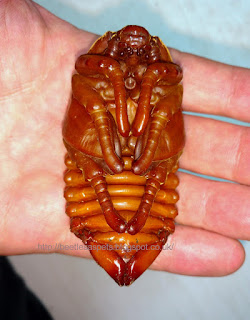Sometimes the beetle transformation from pupa to imago is not always successful. Often beetle ecloses with some deformities, mainly because of the "mechanical" problems. Smaller defects, such as small deformities of hard external parts of the body are normally not life threatening and the beetle live and "function" just fine with them. Big deformities often lead to the early death of the beetle, often already during its dormant period.
One of the most common problems is when the beetle ecloses with wings sticking out, which may happen due to a number of reasons, such as deformities of the elytron which has hardened too fast, or when wings get entangled with remains of the pupa's or larva's skin. Sometimes the beetle's wings get a small mechanical damage and contract infection through the trauma. When you encounter such problems, it often can be solved by "surgically" removing parts of the wings that are sticking out from elytron of the beetle. In this case the damaged parts will be cut off and the remaining parts will be much less in contact with the substrate which is a source of numerous pathogens. After the operation, the beetle needs to be kept in a relatively dry and clean environment for several hours so the cuts will dry out. From my experience, about 90% of the beetles which eclosed with wings sticking out lived normal long lifes after the parts of the sticking out wings were removed. Here is a short video showing such procedure on a female of a Japanese rhinoceros beetle, Allomyrhina dichotoma.
If you have any questions about it please comment here or on youtube,
contact email is beetlesaspets@gmail.com













